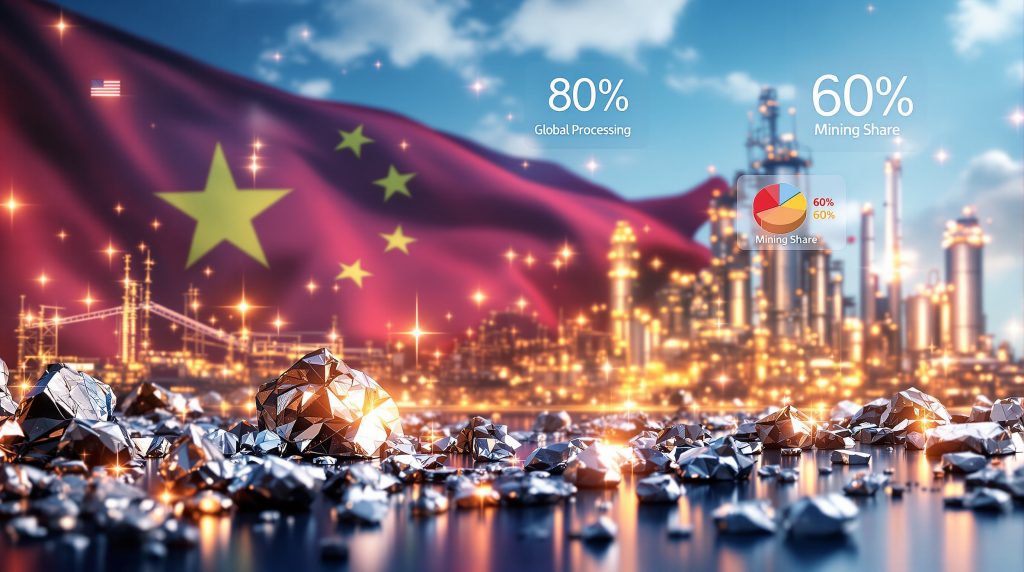Understanding the Scope of China's Rare Earth Restrictions
China implemented comprehensive export licensing requirements for rare earth elements in 2025, fundamentally reshaping global supply chain dynamics for critical minerals essential to modern technology and defense systems. These China rare earths export controls represent the most significant regulatory shift in critical mineral trade since the establishment of international rare earth markets.
The new regulatory framework covers 12 specific rare earth elements including dysprosium, terbium, gadolinium, and yttrium, along with their processed forms such as metals, alloys, oxides, and magnets. According to Reuters analysis published October 23, 2025, these controls extend beyond Chinese-mined materials to include any products worldwide containing Chinese-origin rare earths, creating unprecedented extraterritorial reach that affects even trace amounts of Chinese materials in foreign-manufactured goods.
Key Market Control Statistics:
| Metric | China's Share | Source |
|---|---|---|
| Refined rare earth production | Over 90% | Reuters Breakingviews, October 2025 |
| Rare earth magnet manufacturing | Over 90% | Reuters Breakingviews, October 2025 |
| Heavy rare earth processing capacity | 98% | Reuters Breakingviews, October 2025 |
| 2024 rare earth production value | $6.5 billion | Goldman Sachs via Reuters |
| Potential downstream impact from 10% disruption | $150 billion | Goldman Sachs via Reuters |
The scale of China's dominance becomes clear when examining processing capabilities. While rare earth elements exist in deposits worldwide, the People's Republic has systematically developed refining expertise that competitors cannot quickly replicate. State-backed China Rare Earth Group leads this monopolistic control, particularly over heavy rare earth processing where alternatives remain virtually non-existent.
How Do These Export Controls Actually Work?
The regulatory system operates through mandatory export licenses rather than outright bans, creating administrative barriers that significantly slow international trade flows while maintaining plausible commercial activity. This approach provides Beijing with negotiating leverage while making workaround strategies substantially more complex than simple alternative sourcing.
Implementation occurs through a phased approach, with Reuters confirming that the new rules "partly go into effect in December" 2025. The licensing requirements grant Chinese authorities oversight powers extending far beyond traditional export controls, as they now track materials through multiple processing stages and geographic jurisdictions.
Extraterritorial Application Mechanisms
The most significant aspect of these controls involves their extraterritorial reach. Companies processing Chinese rare earth imports and re-exporting finished products must obtain licensing approval from Chinese authorities, effectively extending Beijing's control throughout global supply chains. This includes manufacturers in third countries who incorporate Chinese-origin materials into their products, even when substantial value-added processing occurs outside China.
A product manufactured in Belgium using Chinese-origin rare earth material cannot be re-exported without Chinese authorization, regardless of Belgian manufacturing contributions or European Union trade policies. This represents a fundamental shift in how export controls traditionally operate, moving from point-of-origin restrictions to supply chain surveillance.
Which Industries Face the Greatest Impact?
The China rare earths export controls create systemic vulnerabilities across multiple critical sectors simultaneously. Furthermore, China's dominance in rare earth processing affects industries from defense to renewable energy, emphasizing the multi-sector dependency that amplifies geopolitical leverage.
Defense and Military Applications
Military systems require the highest-performance rare earth magnets, particularly those incorporating heavy rare earth elements that provide temperature stability and magnetic strength unattainable through alternatives. Key applications include:
• F-35 fighter jet propulsion and guidance systems
• Submarine navigation and sonar equipment
• Precision-guided missile technology platforms
• Advanced radar and communication arrays
• Nuclear submarine reactor control mechanisms
Technology and Electronics Sector
Consumer and industrial electronics depend heavily on rare earth elements for miniaturization and performance optimization:
• Electric vehicle motor magnets utilising neodymium-dysprosium alloys
• Wind turbine generators requiring terbium for high-temperature stability
• Smartphone hard drive components and speakers
• Computer memory storage systems
• Advanced battery technologies for grid-scale energy storage
Energy Infrastructure Dependencies
Renewable energy systems incorporate rare earth elements throughout their operational components:
• Solar panel manufacturing processes requiring specialised compounds
• Wind turbine permanent magnet generators
• Grid-scale energy storage system components
• Advanced power generation equipment
• Electric vehicle charging infrastructure
The analysis emphasises that despite the rare earth market's relatively modest $6.5 billion annual production value, the cascading economic impact across dependent industries could reach $150 billion from just a 10% supply disruption, according to Goldman Sachs calculations.
What Makes Heavy Rare Earths So Critical?
Heavy rare earth elements represent the most strategically vulnerable component of the global supply chain due to their extreme geographic concentration and irreplaceable properties in high-performance applications. However, this concentration creates significant vulnerabilities for global critical minerals energy security as heavy rare earths are "almost exclusively found in China and Myanmar" and are "more complex to process and are vital to high-performance magnets and military-grade weapons and systems."
Light vs. Heavy Rare Earth Comparison:
| Characteristic | Light Rare Earths | Heavy Rare Earths |
|---|---|---|
| Global availability | Multiple countries | China/Myanmar (98%) |
| Processing complexity | Moderate | Extremely complex |
| Applications | Basic magnets, glass polishing | High-performance magnets, defence |
| Temperature stability | Limited | Superior |
| Strategic importance | Commercial | National security critical |
Heavy rare earths like dysprosium and terbium cannot be substituted with lighter alternatives for applications requiring high-temperature stability and superior magnetic properties. These elements maintain their magnetic characteristics at temperatures exceeding 200°C, essential for electric vehicle motors, wind turbine generators, and military systems operating under extreme conditions.
The chemical separation processes for heavy rare earths require significantly more sophisticated technology and expertise compared to light rare earth processing. This technical complexity, combined with China's decades-long investment in specialised separation facilities, creates barriers that competitors cannot overcome quickly regardless of funding availability.
How Are Western Nations Responding to Supply Chain Vulnerabilities?
Western governments have shifted from market-based approaches to direct state investment and guaranteed procurement mechanisms, acknowledging that market forces alone cannot overcome China's structural advantage in rare earth processing. For instance, nations are developing comprehensive Australia strategic reserve initiatives to address these vulnerabilities.
US-Australia Critical Minerals Partnership
Mining stocks in Australia surged following the landmark agreement between Prime Minister Anthony Albanese and US President Donald Trump. The bilateral pact involves both countries pledging "roughly $4 billion in taxpayer money for mining and processing" to break global reliance on Chinese rare earth supplies.
Key Partnership Components:
• Joint funding for mining project development in Australian deposits
• Shared processing facility construction and technology transfer
• Defence stockpile coordination between allied nations
• Long-term off-take agreements providing price floor guarantees
The agreement represents recognition that private investment alone cannot justify the substantial capital requirements and extended development timelines necessary for rare earth supply chain establishment outside China.
Pentagon Strategic Response Initiatives
The U.S. Department of Defense has implemented multiple programmes addressing critical mineral vulnerabilities:
• $1 billion critical minerals stockpile programme: The Pentagon plans substantial inventory replenishment to buffer against supply disruptions
• Strategic partnerships with rare earth producers: DoD collaborations with companies including MP Materials and Lynas address financial hurdles in processing capacity development
• Off-take agreement structures: Long-term purchase guarantees provide price floors incentivising facilities to maintain operations amid volatile markets
Private Sector Development Challenges
Despite government support, commercial rare earth development faces significant implementation obstacles. Lynas Rare Earths, despite becoming "the first commercial producer of those separated rare earths outside China" in 2024, warned in August of "significant uncertainty" regarding its $258 million contract to build a heavy rare earth processing facility in Texas.
This uncertainty highlights the gap between political commitments and industrial execution capabilities, particularly when projects require sustained government support over multiple election cycles.
What Are the Technical Challenges in Building Alternative Supply Chains?
Overcoming China's rare earth dominance requires more than capital investment, as the technical barriers involve specialised expertise accumulated over decades of strategic planning and industrial development. Consequently, understanding these challenges alongside a comprehensive rare earth reserves analysis becomes essential for strategic planning.
Processing Timeline and Infrastructure Requirements
According to Goldman Sachs analysis, building alternative rare earth supply chains involves substantial time commitments:
• Refinery construction and ramp-up: 5 years minimum
• New mine development: Up to 10 years
• Full supply chain integration: 15-20 years for meaningful independence
These timelines reflect not just construction requirements but also the need to develop specialised chemical processing expertise, environmental containment systems, and quality control capabilities that match Chinese production standards.
Critical Workforce Shortages and Skills Gap
The mining industry faces unprecedented human capital challenges that compound rare earth development difficulties:
OECD Mining Workforce Crisis:
• 72% of OECD mining workforce over 35 years old, creating imminent retirement wave
• 221,000 US mining workers requiring replacement by 2029, according to 2023 Center for Strategic & International Studies analysis
• 327 American mining/mineral engineering degrees awarded in 2020 compared to 1,500+ graduates annually from China's leading mining university programmes
Rare Earth Expertise Shortage:
The separation and refining expertise gap represents the most critical constraint. There may be "just a couple of dozen experts in separation and refining in the US, Europe and Japan collectively, compared to thousands in China." This asymmetry cannot be resolved through traditional market mechanisms or short-term training programmes.
Chinese Talent Protection Measures
Beijing has implemented systematic measures to prevent rare earth expertise emigration. Chinese authorities "started to catalogue the country's experts in this field to ensure they don't travel abroad and reveal industry secrets," effectively creating a fortress of critical minerals knowledge.
This talent protection strategy recognises that rare earth processing involves substantial tacit knowledge developed through hands-on experience that cannot be easily transferred through documentation or formal education programmes.
Environmental and Regulatory Complexities
Western rare earth processing facilities must address environmental concerns that add years to development timelines and substantial costs to project budgets. Unlike China's more permissive regulatory environment during its rare earth industry development phase, OECD countries require comprehensive environmental impact assessments, community consultation processes, and waste management systems that meet stringent safety standards.
Rare earth processing generates radioactive waste, acid drainage, and toxic chemical byproducts requiring specialised containment and disposal infrastructure that many Western locations cannot easily accommodate.
Can Countries Successfully Bypass These Controls?
Historical evidence suggests that while materials can reach Western end-users through intermediary countries, the new extraterritorial controls significantly increase costs and risks compared to previous export restrictions. In addition, the development of mining innovation trends offers potential pathways for diversification.
Re-export Hub Strategies and Limitations
Following China's 2024 germanium and gallium export restrictions, both materials "continued to make their way to American firms, probably thanks to re-export hubs like Belgium," according to study findings. However, the rare earth controls present more substantial challenges due to their comprehensive scope and tracking mechanisms.
Bypass Method Constraints:
• Increased transaction costs and supply chain complexity
• Limited availability of alternative processing capabilities
• Potential diplomatic consequences for intermediary countries
• Quality control and specification verification challenges
• Extended delivery timelines affecting just-in-time manufacturing
Stockpiling Effectiveness and Limitations
Government stockpiling provides temporary buffer capacity but cannot address long-term supply security requirements. The Pentagon's $1 billion inventory replenishment programme, while substantial, faces inherent limitations:
• Storage costs and potential material degradation over time
• Evolving technology requirements making stockpiled materials obsolete
• Limited strategic reserve capacity relative to industrial consumption
• Market volatility impacts affecting procurement timing and costs
Analysis suggests that "with avenues to offset the impact of tougher Chinese curbs narrowing, expect more public-private and cross-border initiatives" as traditional workaround mechanisms become less viable.
What Does This Mean for Global Technology Development?
The China rare earths export controls are accelerating fundamental shifts in technology development strategies and international trade relationships, pushing governments and corporations toward supply chain restructuring that will define industrial competitiveness for decades. Furthermore, this shift is driving the establishment of European CRM facility initiatives to reduce dependency.
Innovation Acceleration in Alternative Technologies
Supply constraints are driving unprecedented research investment into rare earth alternatives and substitution technologies:
• Development of rare earth-free motor designs for electric vehicles
• Advanced recycling processes for urban mining of electronic waste
• Alternative magnetic materials research using abundant elements
• Improved efficiency technologies reducing rare earth requirements per unit
These innovation efforts require substantial capital investment and technical risk-taking that market forces alone historically have not justified, leading to increased government research funding and strategic technology partnerships.
Geopolitical Realignment and Resource Diplomacy
Countries are restructuring trade relationships and industrial policies around critical mineral security considerations rather than pure economic efficiency:
• Friend-shoring supply chain strategies prioritising allied nations over lowest-cost suppliers
• Increased government intervention in mining sectors through direct investment and regulatory incentives
• Strategic resource diplomacy initiatives linking trade agreements to critical mineral access
• Technology transfer restrictions preventing advanced processing knowledge from reaching competitors
This shift represents a fundamental departure from globalisation principles toward strategic autonomy in critical supply chains, with implications extending far beyond rare earth markets.
How Long Will Western Dependence on China Continue?
Achieving meaningful supply chain diversification requires sustained commitment over multiple decades, with realistic timelines extending well beyond current political planning horizons.
Supply Chain Independence Timeline:
| Development Stage | Timeframe | Primary Constraints |
|---|---|---|
| Mine exploration and permitting | 3-5 years | Environmental approval, geological uncertainty |
| Mine construction and commissioning | 5-7 years | Capital availability, technical expertise |
| Processing facility development | 5-7 years | Specialised equipment, regulatory compliance |
| Workforce development and training | 10-15 years | Educational pipeline, knowledge transfer |
| Full supply chain integration | 15-20 years | Scale requirements, cost competitiveness |
Even with accelerated government investment and international cooperation, analysis emphasises that China's dominance "was the result of decades of strategic planning and investment, and it'll probably take just as long for another country to match China's capabilities."
This timeline reflects not just industrial capacity building but also the need to develop institutional knowledge, supplier networks, and technical expertise that cannot be rapidly acquired through market transactions or government mandates.
Realistic Expectations for Supply Security
Western nations face a prolonged period of vulnerability requiring strategic adaptation rather than complete supply chain replacement. Even successful alternative development will likely result in higher costs and reduced efficiency compared to Chinese production, necessitating government subsidies or consumer acceptance of premium pricing for supply security.
The transition period will require careful balance between immediate security needs through strategic stockpiling and longer-term capacity building through sustained industrial development programmes.
Future Implications for Global Markets
The China rare earths export controls represent a fundamental shift toward resource nationalism and strategic competition over critical materials that will reshape international trade relationships and industrial development patterns for the foreseeable future.
This trend will likely expand beyond rare earth elements to encompass other essential minerals and advanced technologies, creating a more fragmented global economy where strategic considerations override pure economic efficiency in supply chain decisions.
Companies must prepare for sustained supply chain uncertainty while investing in long-term alternatives that reduce dependence on concentrated sources of critical materials. This preparation involves not just alternative supplier development but also fundamental redesign of products and processes to minimise vulnerability to supply disruptions.
Governments face the challenge of maintaining industrial competitiveness while building strategic autonomy in critical supply chains, requiring unprecedented coordination between public and private sectors over timelines extending well beyond normal political cycles.
Disclaimer: This analysis incorporates forecasts and projections based on current market conditions and policy trends. Actual developments in rare earth supply chains, government policies, and international trade relationships may differ significantly from these projections due to technological breakthroughs, geopolitical changes, or unforeseen market developments.
Looking to Capitalise on Critical Minerals Market Disruptions?
Discovery Alert's proprietary Discovery IQ model delivers instant notifications on significant ASX mineral discoveries, including rare earth and critical mineral projects positioned to benefit from global supply chain restructuring. With China's export controls creating unprecedented opportunities for alternative suppliers, subscribers gain rapid insights into actionable investment opportunities that could emerge as Western nations accelerate critical minerals development programmes.




